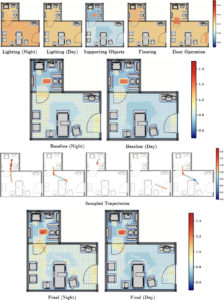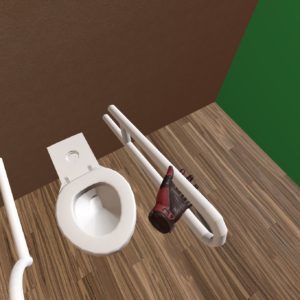One of the greatest fears for anyone with a frail, aging family member is that the person could be seriously injured in a fall. Falls are the leading cause of fatal and non-fatal injuries for older Americans, according to the National Council on Aging. One in four over the age of 65 experience a fall each year.

University of Utah mechanical engineering associate professor Andrew Merryweather and School of Computing assistant professor Tucker Hermans are creating a new computer algorithm they believe can reduce the number of accidental falls in a home, hospital or care facility. This unique software tool analyzes something that’s never been calculated before – the environmental conditions such as furniture and the layout of the room and how they might contribute to the risk of a fall.
“The computer algorithm incorporates information about the room, such as the type of furniture in the room, the arrangement of the furniture and how the patient moves about in the room,” Merryweather said.

Leveraging Hermans’ expertise in computing and Merryweather’s knowledge in biomechanics and human movement, the pair, along with collaborators from the U’s School of Nursing, Department of Physical Therapy and Athletic Training, and U mechanical engineering doctoral students Roya Sabbagh Novin and Sarvenaz Chaeibakhsh, are developing the algorithm to assess characteristics in the room and determine its risk factors for a fall as well as suggestions for better configurations that help mitigate accidents. Their research was recently published in the journal Health Environments Research & Design.
 Using a library of available furniture, the algorithm rates the risk factor of each chair, bed and other fixtures in a room for their support, stability and their relationship to other objects. The software also analyzes thousands of potential layouts of the furniture – incorporating factors such as biomechanics, human motion related to a fall, and the manner in which the person walks – to produce the configuration with the lowest risk. Finally, the algorithm produces a color-coded heat map of the room that indicates which areas have greater and lower risks for a fall. The software can work with virtual reality headsets so users can compare new room configurations with the original layout.
Using a library of available furniture, the algorithm rates the risk factor of each chair, bed and other fixtures in a room for their support, stability and their relationship to other objects. The software also analyzes thousands of potential layouts of the furniture – incorporating factors such as biomechanics, human motion related to a fall, and the manner in which the person walks – to produce the configuration with the lowest risk. Finally, the algorithm produces a color-coded heat map of the room that indicates which areas have greater and lower risks for a fall. The software can work with virtual reality headsets so users can compare new room configurations with the original layout.
“We can see which objects contribute to the fall and which patient activities contribute to the risk,” Merryweather said. “From that we can understand how to better design the room to facilitate those patient activities.”
 When designing a room for elderly care or for people with disabilities, architects and construction companies currently consider such factors as cost of building the room, aesthetics, or infection control. But Merryweather believes this new algorithm can now easily and effectively recommend better room designs and furniture layouts with patient safety as priority.
When designing a room for elderly care or for people with disabilities, architects and construction companies currently consider such factors as cost of building the room, aesthetics, or infection control. But Merryweather believes this new algorithm can now easily and effectively recommend better room designs and furniture layouts with patient safety as priority.
Merryweather said the team’s goal is to produce an algorithm that can reduce the risk of a fall by around 25%. The group’s research is funded by a five-year $1.9 million grant from the U.S. Department of Health and Human Services’s Agency for Healthcare Research and Quality. He said he hopes to have the software validated by the end of next year and have a completed product by the end of the five-year project in 2022.